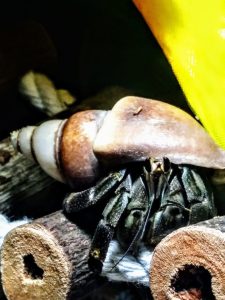
Written by Vanessa Pike-Russell
Hermit crabs are advertised as cheap and easy to maintain, which is not necessarily true. To keep your hermit crabs happy and healthy, you will need to provide a lot more than food and water. In this article we will give you a list of essential and optional items you need. Also you will find some info on basic care and upkeep of the tank, considerations when purchasing.
1. ESSENTIALS
Glass tank with lid:
A glass tank is preferred over plastic tanks, which will scratch and will not be able to hold the humidity within the ventilated lids. A glass lid on a glass tank helps keep the temperature and humidity within hermit crab’s habitat, allowing for a slight gap for airflow. This airflow of fresh air into the humid environment will help to cut down on mould and bacteria, which can cause illness and even death among hermit crabs, often detected by a musty or ammonia odor.
Substrate:
Substrate is what we call the material that lines the bottom of the tank, and creates the ‘beach’ within your crabitat. The most popular substrates being: sanitised beach sand; damp coconut fiber (eg. T-Rex Forest Bed), quality play sand (eg. Tropical Play Sand, Aragonite sands, Play Box sand and others not used for concrete or building industry). You will need enough of a depth to cover your largest Land Hermit Crab; three times the height is sufficient for them to bury.
Heat Source:
An Under Tank Heater or U.T.H. is a heat pad made especially for small animals and reptiles. Despite the name, the UTH is used on the back wall of your habitat. Popular brands are: Euro-Rep (UK/Aus); Four Paws(U.S.); PetZone (Australia); ZooMed(UK/Aus and US versions). An U.T.H. is used to keep the hermit crabs warm by gently warming the glass wall of the tank and objects in the tank.. You may need a thermostat with probe to regulate your temperature.
If you are more experienced pet owner, an overhead light can also provide warmth in your tank as well as needed UVB exposure.
Three Dishes:
Use non-metallic, non-porous dishes for your fresh water dish, another for your ocean water pond, and one for food. Water dishes must be deep enough for self submersion by your largest crab.
Thermometer:
A thermometer is used to observe the temperature inside the tank. Thermometers come in three main types: the adhesive fish tank style, based on a sticker that changes colour as the temperature at the glass raises; the circular reptile-type thermometers which are based on a coil which contracts or expands; a digital gauge which uses a probe and allows you to measure the temperature at more than one location.
Hygrometer:
A hygrometer is used to observe the humidity inside the tank. Just as with temperature, humidity is very important. If the humidity drops and the air is dry, your land hermit crab will have difficulty in breathing through their modified gills, which act as lungs when moistened and correctly functioning.
Water Ager/Conditioner:
Water Ager or Conditioners are very important if the quality of water is not suitable for use with fish in an aquarium. It is important to removes harmful substances from tap water such as chlorine and heavy metals, which can make hermit crabs ill.
Ocean Salt:
Ocean water is required for land hemit crabs. Mix according to package directions for a salt water aquarium A salinity of 34 to 36 ppt or a specific gravity from 1.021 to 1.026 is a good target.
Food:
It is important to feed a balanced diet, with new foods offered on a daily basis. Commercial pellets should never be fed. Foods containing ethoxyquin, fish meal, copper sulfate, added salt, sugar, preservatives should never be fed. Our hermit crab food guide.
2. CHECKLIST OF CARE:
Daily
Empty and refill water dish and salt water pond
Empty and clean the food dish (no chemicals)
Offer a different food each day, remove previous meals when funky
Check the humidity level is within range (50-60% or relative humidity 70-80%)
Check the temperature 75-85F and that it is stable
Verify lid is secure and escape proof
Visually inspect power cords and airlines for signs of damage
Weekly
Clean all bowls and dishes without chemicals
Pick through the substrate for food and feces
Remoisten/ replenish your moss
Monthly
Check decor for mold or fungus
Wipe down walls of tank with vinegar and water, or ocean water mixture.(Avoid cleaning chemicals eg. bleach)
Inspect water pools for damage or signs of leaks or cracks
If you use filters, change your filters and thoroughly clean the housing
Bi-annually
Check batteries in gauges or sensors
Annually
Replace your UVB bulb
3. The Big Picture
As you would have already guessed, caring for a land hermit crab is more than just food and salt. The initial set up for a land hermit crab can include much more than you previously thought. The good news is that there will never be a costly vet bill, no real expenses for food or medicine, no reproduction in your crabitat, or having to worm and groom.
The main costs are those of the housing; heating; substrate; gauges; water pools and food bowl; tank decorations; background and other items such as seashells; quality food for a proper diet… the list goes on. You are trying to offer everything a land hermit crab needs while in captivity, the essentials they cannot live without.
If you cannot meet the needs of a land hermit crab, then it is best to wait until you can. Most pets have a similar start up cost, which enables them to live comfortably and have a happy home and environment.
Contrary to popular belief, Land Hermit Crabs are not throwaway pets and deserve the same humane treatment as other animals do.
If at any time you find that you cannot meet the needs of your land hermit crabs, or decide that they are not the pet for you, please place them for adoption.
For more information about how to sign up to adopt hermit crabs, or place your own hermit crabs up for adoption.
4. Responsible Pet Ownership
Why have a pet land hermit crab?
Land Hermit Crabs are an interesting pet that when kept healthy and happy will live for a number of years, if you are willing to pay for the essentials. If you can provide heat, humidity, hide spots, good hygiene, food and suitable water then you are part the way to keeping healthy hermit crabs.
Choose Carefully
It is important that you choose the hermit crabs that are suitable for your family and crabitat. If you only have room for a small crabitat in your home, then it may be best that you choose small hermit crabs. Larger hermit crabs need more room to move about within your tank, and will need larger versions of water dishes, food dishes, hideouts and the like. I
Your Family Lifestyle
Land Hermit Crabs need fresh food and water every day. If you are not able to be there to provide these essential needs, it is important that you find someone to look after your hermit crabs if you are gone for more than two days.
Your Home Environment
You will need to find a suitable spot within your home for the placement of your land hermit crab’s crabitat. Somewhere out of drafts, and away from any chemicals, insecticides or fumes. Typical locations are in the lounge room or in bedrooms, however the noise of nocturnal hermit crabs partying the night away has kept more than one hermit crabber awake. If possible, the crabitat should be placed in an area which does not receive a heavy traffic,allowing for some privacy and quiet.
Your Time
You will need to spend at least five minutes at morning and night time refilling water and food dishes; picking through the substrate for any food that has fallen or been dragged out of the food bowl and to check for signs of any problems or illness. View the checklist for more information on what is needed each day, week and month.
The Cost
The initial set-up is something that you need to see as essential. There should be no cutting corners when it comes to the crabitat (glass with lids are best); heating (under tank heater, even through summer); gauges (tools to enable you to keep the humidity and temperature at suitable levels);substrate (to line the tank with and enable your crabs to dig), etc. They are all necessary expenses and you will need to set up the crabitat before buying your new pets, or they will not survive very long.
5. Starting Off On The Right Peripod (FOOT)
Where Do I Purchase?
It is important that the hermit crabs are in good health when you buy them,as it is often very difficult to undo past damage, especially poor hygiene which leads to bacteria, fungus.
Try to purchase hermit crabs from a pet store which has a range of hermit crab accessories, or at least from a pet shop that will get items in for you on request. If the store keeps their hermit crabs in wood shavings or other unsuitable substrate, I would either try and recommend a more suitable one (sand, coral sand, playsand, etc) or find another pet store which will provide you with healthy hermit crabs that start off on the right foot.
Studies have shown that poor conditions and bad hygiene have led to bacteria contamination, which can cause limbs to drop off, mould and fungus, leaving them stressed and in many cases, they will not make it through a moult.
6. Important Considerations
Does each have a place where it can de-stress?
Each crab should be able to retreat within the security of a hiding hut,cave or space where it can feel comfortable and secure within its surroundings.
Will each hermit crab have enough space to dig down and moult?
Moulting is responsible for most of the deaths of land hermit crabs in captivity They need to have adequate moulting conditions or they will not survive The substrate should be deep enough so that it is triple the height of the largest hermit crab.
Do I have three seashells for each size of hermit crab?
Each hermit crab should have access to at least three seashells of its size and shape, and they should include some of the more popular seashells for land hermit crabs for that size. If it cannot find a seashell to fit, your hermit crab may become very crabby. If you cannot take responsibility to find quality seashells for each hermit crab, then you should stick to hermit crabs of the same size. At least then, they will have a range of shells to choose from.
Signs of Illness
If you see a hermit crab with signs of illness in a pet store, it is often not a wise idea to take it home, especially if the signs are of mould, bacteria, mites, fungus or other illness that may spread to your current hermit crabs. Pet Stores are not allowed to sell ill animals. If a hermit crab dies within twenty-four hours, take it back to the pet store and ask them for a replacement.


